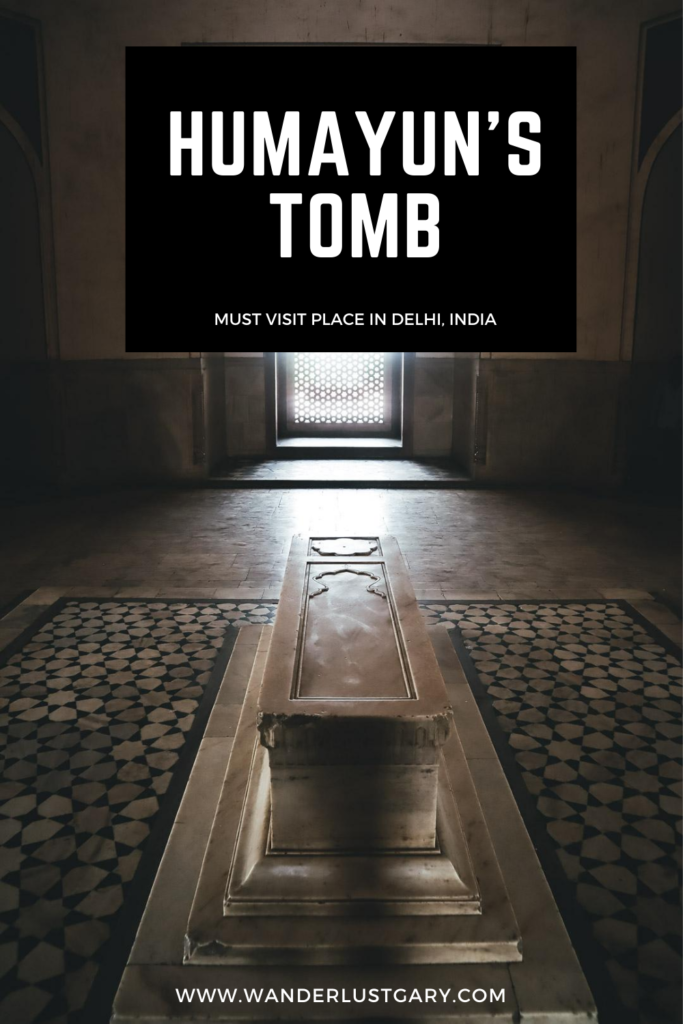Delhi’s most magnificent monument, the Humayun’s Tomb, depicts an amazing architecture of the Mughals era in India. A must visit place in Delhi if you love art and history. The tomb is visited by millions by Indian and International tourists every year. On my trip to Himachal Pradesh, I had just a day to spend in Delhi, and Humayun’s Tomb was on top of my Bucket list.
The tomb was constructed in the year 1570 on the orders from Hamida Banu Begum, the widow of Humayun as a gesture of affection for her husband. The monument resembles the great Taj Mahal but for completely different reasons which are still a mystery. There are many amazing facts about Humayun’s tomb that will keep you intrigued.

The Humayun’s tomb is considered a UNESCO World Heritage Site for its fine architecture and history. Over the years, the tomb came to a resting place for other Mughal family members too.
History and Death of Humayun
Humayun was the son of Babur, the Founder of the Mughal Emperor. Babur died in the year 1530 due to Fever and Humayun was ascended to the throne at the age of 22.
Shortly after the ascension of Humayun, he was defeated in the battle of chausa and Kannauj by Sher Shah Suri of the Suri Empire. Humayun then left India and spent 15 years in Persia, only to come back years later to win back his lost Empire and re-establish the Mughal empire. Humayun achieved this victory with the help of the armies from the Safavid dynasty of Persia.
The Death of Humayun is something I would have not thought of happening in this way. A year later after regaining the kingdom, in 1556 Humayun had his final breath. When Humayun heard the muezzin’s call for prayers that evening, he was in his library at Dinpanah and rushed in a hurry with arms full of books. He then caught his foot on his robe and tumbled down the stairs and hit his head. Humayun was dead three days later.
Humayun was first buried in a place at Purana Qila in Delhi. Later the tomb had to be moved to a place called Sirhind in Punjab. However, the tomb was moved to Delhi in the year 1570.
The Architecture of Humayun’s Tomb
The Humayun’s tomb was the first major grandiose tomb of the Mughal empire in India. The idea of the great Taj Mahal was made in resemblance to the Humayun’s tomb. It was probably the first garden-tomb in India.



The magnificent Persian architecture attracts tourists from all around the world. The symmetry of the monument and the gardens in the complex are a marvelous visual treat. One of the major features of the monument is its marble dome.
The Humayun’s complex also has many other important structures. There are more than 150 other tombs of the Mughal family members.

The Tomb Of Isa Khan
Another important monument in the complex is the Tomb and Mosque of Isa Khan. he was an Afghan noble. The tomb was built-in 1547.


The other tombs present in the complex are
- Nila Gumbad
- Bu-Halima’s Tomb and Garden
- Barbar’s Tomb
- Afsarwala’s Tomb and Mosque
Humayun’s Tomb is a perfect example of the Mughal Empire, Persian Architecture, and history of Mughals in India. I would strongly recommend you add this palace on to your bucket list. It is definitely a must-visit place in Delhi.
Interesting Facts about Humayun’s Tomb

- It is a UNESCO World Heritage Site
- First Garden Tomb of India
- The complex houses 100 other tombs
- Made by a Wife for her Husband
- Marble dome is about 42.5 meters in height
- The tomb was completed in 8 years’ time.
- The inspiration behind the majestic Taj mahal
How To Reach Humayun’s Tomb?
There are several means of transport such as by Air, Railways, and roadways which will take you to the capital city, Delhi.
The Humayun’s Tomb is approximately 3 km from the Hazrat Nizamuddin railway station which would take around 10min to reach by road.
You can also choose to travel by Delhi Metro. The nearest metro station is Jor bagh or JLN stadium depending where you travel from.
You can also choose to hire a private car or local transport such as Tuk-tuk or local buses.
Save this on Pinterest if you want to read the blog later
















